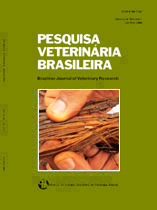 |
|
|
|
Year 2013 - Volume 33, Number 6
|

|
Induction of resistance to Palicourea aeneofusca (Rubiaceae) poisoning by the continuous administration of non-toxic doses, 33(6):731-734
|
ABSTRACT.- Oliveira M.D., Riet-Correa F., Carvalho F.K.L., Silva G.B., Pereira W.S. & Medeiros R. M.T. 2013. [Induction of resistance to Palicourea aeneofusca (Rubiaceae) poisoning by the continuous administration of non-toxic doses.] Indução de resistência à intoxicação por Palicourea aeneofusca (Rubiaceae) mediante administração de doses sucessivas não tóxicas. Pesquisa Veterinária Brasileira 33(6):731-734. Hospital Veterinário, CSTR, Universidade Federal de Campina Grande, Patos, PB 58700-000, Brazil. E-mail: rmtmed@uol.com.br
Palicourea aeneofusca (Müll. Arg.) Standl. is a toxic plant which contains sodium monofluoroacetate (MFA). With the objective to investigate if repeated non-toxic doses of P. aeneofusca induce resistance to the intoxication by this plant, 12 goats were distributed in two similar groups. In Group 1, resistance was induced by the administration of the dry plant, during four alternate periods: 0.02g/kg during 5 days, 0.02g/kg during 5 days, 0.03g/kg during 5 days, and 0.03g/kg during 5 days. Between the first and second period of administration and between the second and the third period, the goats did not ingest P. aeneofusca for 10 days. Between the third and the fourth administration period the goats did not ingest the plant during 15 days. One goat died suddenly during the third administration period when was ingesting 0.03g/kg. The goats from Group 2 were not adapted to the consumption of P. aeneofusca. Fifteen days after the end of the adaptation period in Group 1, both groups ingested dry P. aeneofusca in the daily dose of 0.03g/kg during 19 days. From day 20 the daily dose was increased to 0.04g/kg, which was ingested for 12 days. The goats that showed clinical signs were removed from the experiment immediately after the observation of first signs. One goat from Group 2 showed clinical signs of poisoning and died on the 12th day of ingestion, and two showed clinical signs on day 24th; one recovered and the other died. At the end of the 31 days administration period, a new group (Group 3) with three goats was introduced in the experiment to investigate if the goats that did not become poisoned in Group 2 had acquired resistance. The three goats from Group 1, five goats from Group 1, and three from Group 2 started to ingest a daily dose of 0.06g/kg of dry P. aeneofusca. On the third day of ingestion the three goats from Group 3 showed clinical signs. Two died suddenly and another recovered 10 days after the end of ingestion. All goats of Groups 1 and 2 ingested 0.06g/kg/day during nine days without showing clinical signs. These results demonstrated that non-toxic repeated doses of P. aeneofusca increase significantly the resistance to the poisoning, and that this technique possibly could be used to control the poisoning by P. aeneofusca or other toxic Palicourea species. The results of previous research work suggest that resistance is due to the proliferation of MFA degrading bacteria in the rumen. |
| |
|
|
| |
|
 |